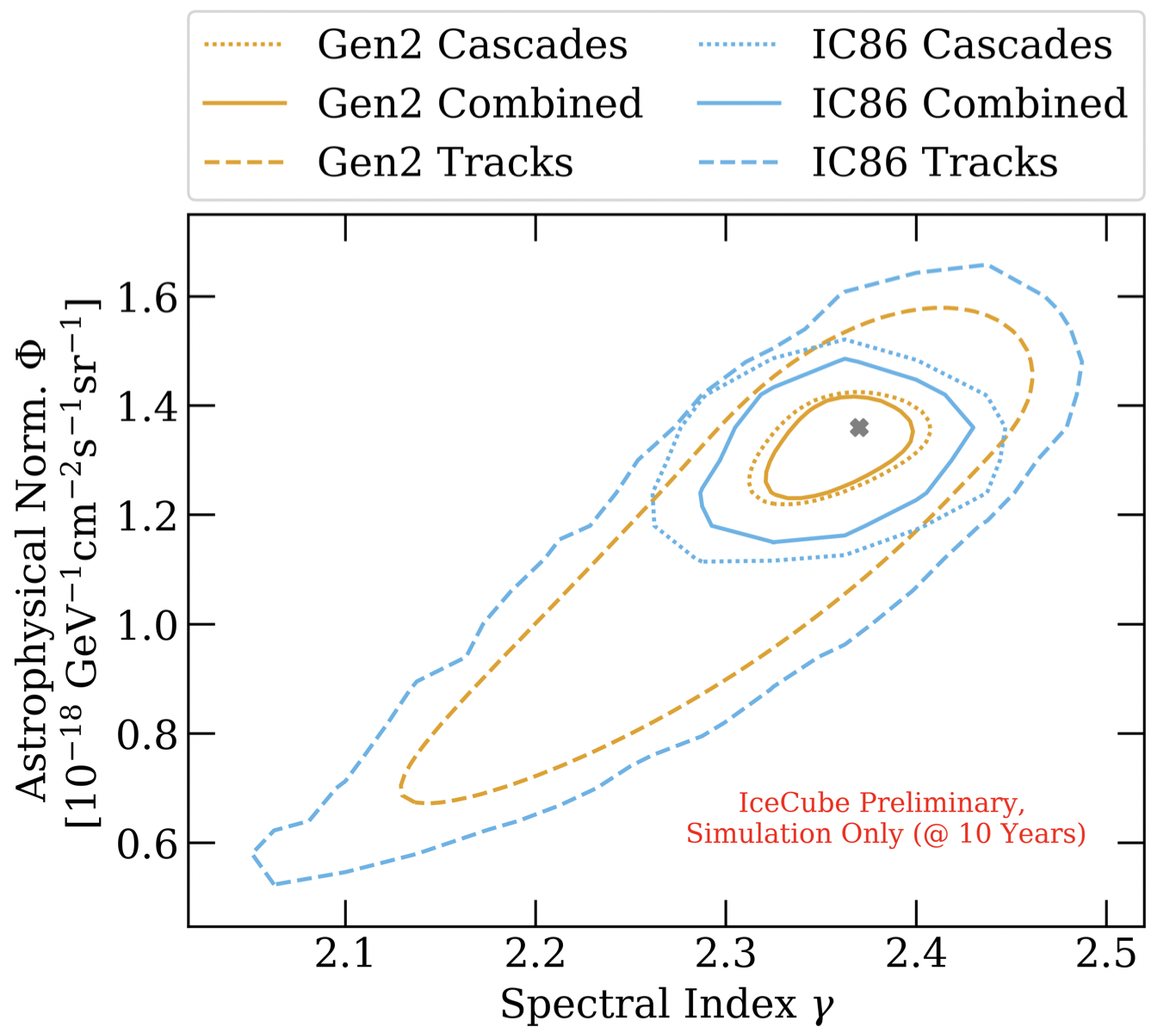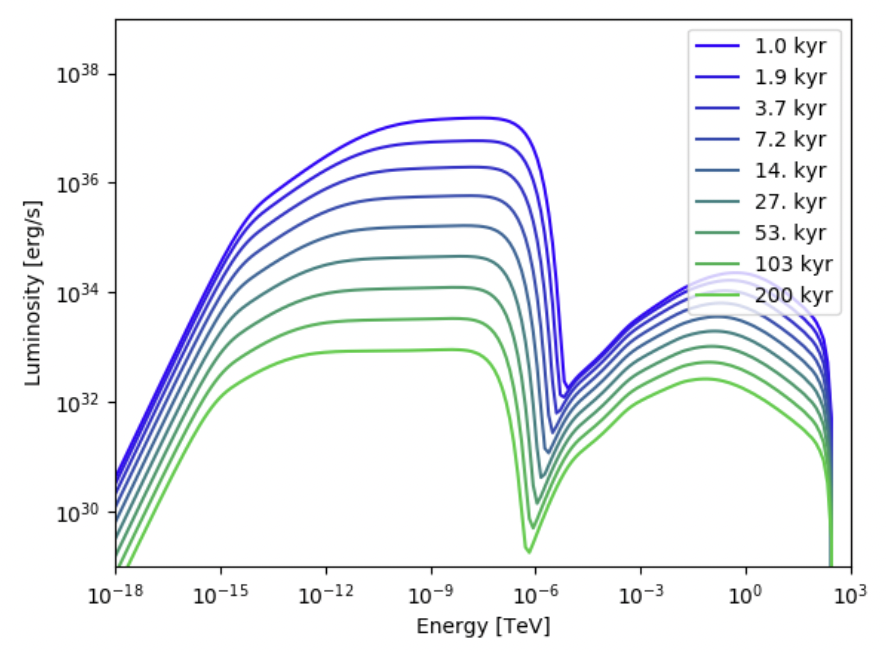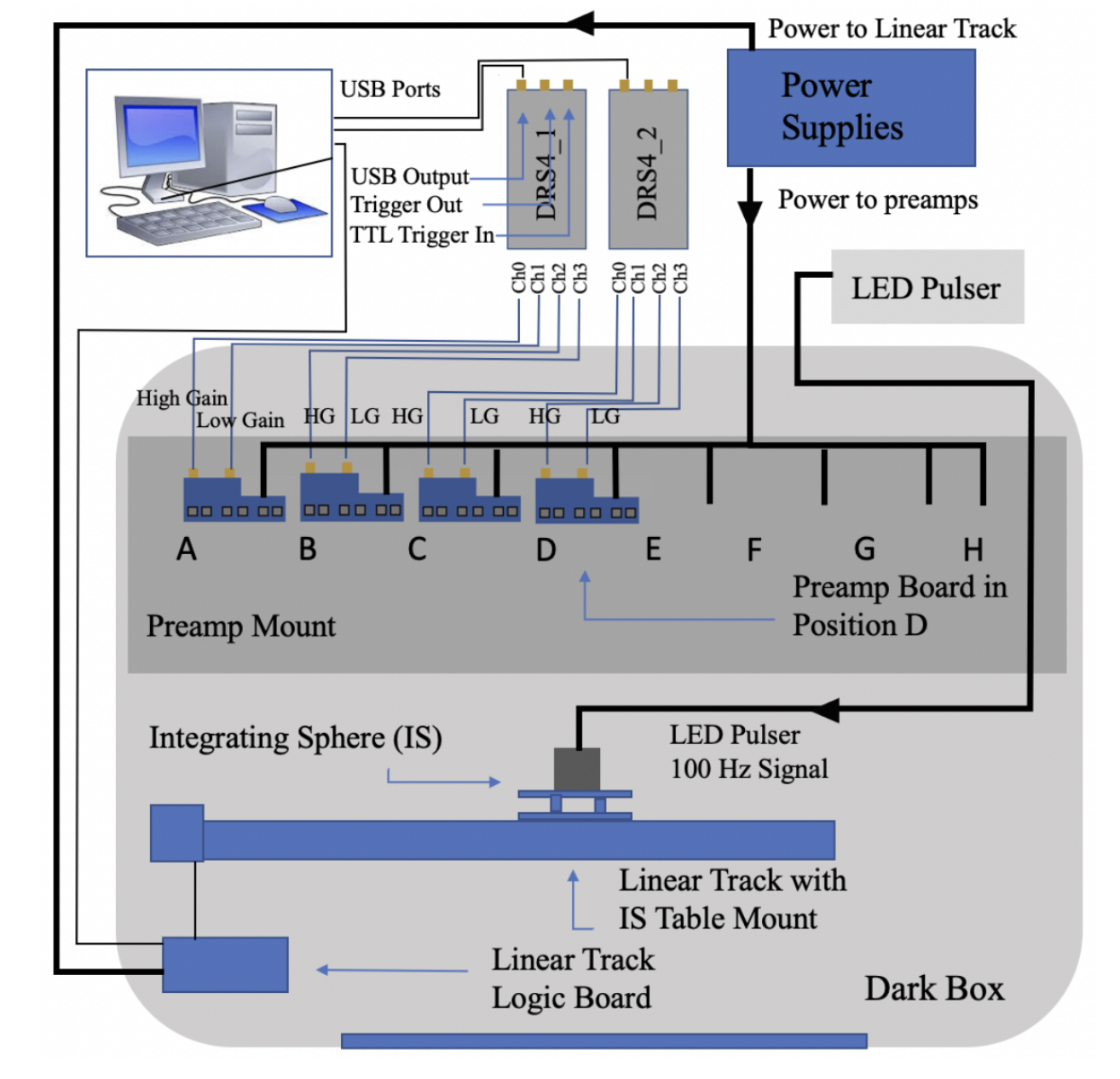Research at Michigan State University (Ongoing)
Astrophysical and Atmospheric Neutrinos
Since joining MSU, I have become invested in modeling the diffuse neutrino spectrum. IceCube observes a near-isotropic, equal-flavor flux of astrophysical neutrinos. In-ice interactions leave track and point-like (cascade) radiative topologies, related to neutrino flavor and interaction type. Constructing high-purity astrophysical data sets requires rejection of the atmospheric cosmic-ray background. Final-level track and cascade selections provide sensitive probes of astrophysical energy dependence. I have recently forecasted sensitivity of a combined analysis of diffuse selections for IceCube-Gen2-Optical, the proposed extension of the existing IceCube array. At right is an image of ten-year sensitivity to a power-law astrophysical spectrum. Results were presented here . I am now pursuing adaptations to improve modern constraints on astrophysical structure and atmospheric systematics.
IceCube's astrophysical diffuse intensity exceeds expectations set by the diffuse gamma-ray sky. Today, only one source related to these highest-energy neutrinos has been identified – the blazar TXS 0506+056. While this multimessenger association triggered initial interest in gamma-ray correlated AGN activity, similar sources may exist in environments opaque to high-energy photons. I now work with my advisor, Nathan Whitehorn, on investigating more robust tracers of neutrino activity in jetted sources.
Event Reconstruction and Instrumentation
IceCube's angular resolution remains significantly impacted by our description of the optical properties of Antarctic ice. I am currently working to modernize IceCube's most physically-realistic, likelihood-based event reconstruction to address this issue. Incorporating complete ice realism within our photon expectations would improve angular resolution by a factor of two, greatly benefiting point-source science.
The IceCube Upgrade is a dense extension to be deployed within the existing IceCube footprint in the Austral Summer of 2025-2026. Michigan State University will play a large role in construction and testing of the optical modules. New sensor design and configuration of multi-sensor strings will enable improved low-energy sensitivity and understanding of detector systematics.

Previous Work at the University of California, Los Angeles
Secondary Neutrino Production
In my final years at UCLA, I collaborated with both Nathan Whitehorn and Alexander Kusenko. Our work was one of the first experimental tests for the production of secondary neutrinos through a line-of-sight interaction between a source’s cosmic rays and extragalactic background light (EBL). Specifically, this signal expectation was used to gauge the flux contribution from an astrophysical source class (subpopulations of active galactic nuclei or starburst galaxies) to the IceCube diffuse spectrum. The secondary neutrino flux was constrained to low percent levels of the IceCube diffuse intensity. At right is an image of 95% flux upper limits placed for starburst galaxies. Results were reported here .

Galactic Gamma-Ray Sources
I have also worked with VERITAS, an array of imaging atmospheric Cherenkov telescopes used for the study of gamma-ray sources. In 2019, I performed a study of the binary source HESS J0632+057. Time-dependent spectral and morphological analyses were carried out, and a new measurement of the system’s period was derived. This work was advised by Rene Ong.
In winter of 2020, I began to develop a new population study, broadband spectral and morphological analyses of the fourteen VERITAS candidate PWNe (pulsar wind nebulae), bolstered by updated gamma-ray measurements. Spectral energy distributions (SEDs) were modeled and constructed for each source. A Markov Chain Monte Carlo was used to deconvolve each SED into contributions by respective radiative process. Additionally, I created numerical software to model the archetypal time evolution of PWNe, used to gauge a source’s deviation from this baseline model. This project helped establish the mechanism driving the highest energy emissions of each source, shedding light on the object's nature. A plot of time-dependent PWN spectral evolution is shown at right (synchrotron and inverse Compton components).

Development of the GAPS Time-of-Flight System
I began my research involvement in spring of 2018 under Rene Ong, assisting with the development of instrumentation for GAPS (General AntiParticle Spectrometer), an indirect search for dark matter. I was responsible for the testing and characterization of multiple versions of SiPM (silicon photomultiplier) and preamplifier components designed for the time-of-flight system. Through summer of 2019 into winter of 2020, I developed a plan for the mass testing of hundreds of final, flight version SiPM/preamplifier electronics. This included authoring a procedure for testing and analysis, designing a custom, automated test bed, machining, construction, Arduino automation (facilitated by NIM logic modules), initial testing and analysis. A cartoon schematic of the light-tight testing setup is shown at right. I look forward to GAPS' Antarctic flight in the near future.
